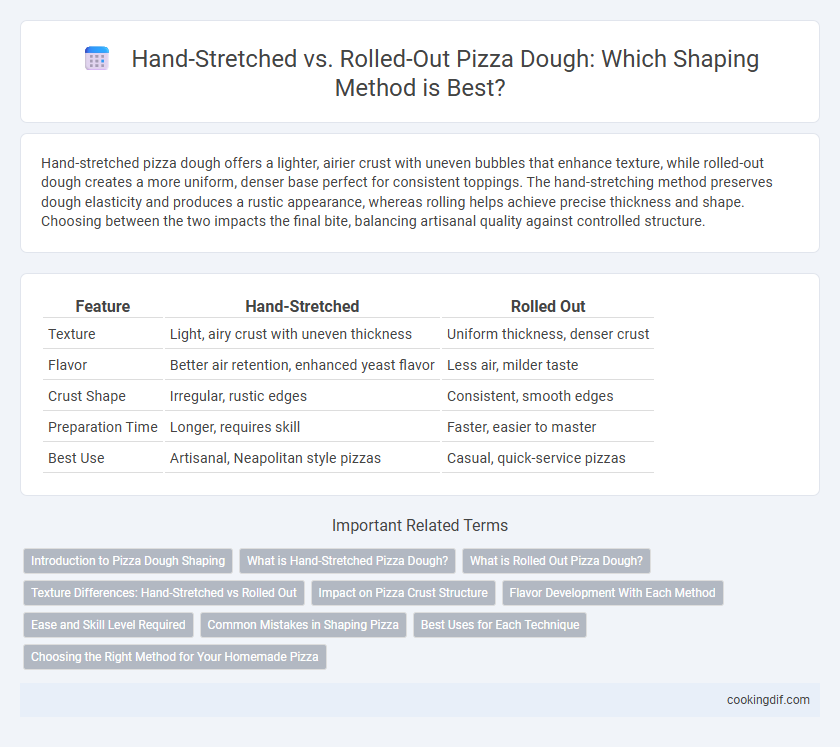Hand-stretched pizza dough offers a lighter, airier crust with uneven bubbles that enhance texture, while rolled-out dough creates a more uniform, denser base perfect for consistent toppings. The hand-stretching method preserves dough elasticity and produces a rustic appearance, whereas rolling helps achieve precise thickness and shape. Choosing between the two impacts the final bite, balancing artisanal quality against controlled structure.
Table of Comparison
| Feature | Hand-Stretched | Rolled Out |
|---|---|---|
| Texture | Light, airy crust with uneven thickness | Uniform thickness, denser crust |
| Flavor | Better air retention, enhanced yeast flavor | Less air, milder taste |
| Crust Shape | Irregular, rustic edges | Consistent, smooth edges |
| Preparation Time | Longer, requires skill | Faster, easier to master |
| Best Use | Artisanal, Neapolitan style pizzas | Casual, quick-service pizzas |
Introduction to Pizza Dough Shaping
Hand-stretched pizza dough preserves air bubbles, creating a lighter, chewier crust with a desirable texture essential for traditional Neapolitan-style pizzas. Rolled out dough offers a more uniform thickness and denser crust, often preferred for New York-style or thin-crust pizzas. Understanding these shaping techniques impacts the final crust structure, texture, and overall pizza quality.
What is Hand-Stretched Pizza Dough?
Hand-stretched pizza dough involves manually pulling the dough to achieve an even thickness, preserving its airy texture and creating a chewy crust with a rustic appearance. This technique prevents overworking the gluten, resulting in a light, elastic base ideal for Neapolitan-style pizzas. Choosing hand-stretched dough enhances flavor development and ensures a crust that crisps perfectly in high-temperature ovens.
What is Rolled Out Pizza Dough?
Rolled out pizza dough is a thin, evenly flattened base achieved by pressing dough with a rolling pin, which creates a consistent thickness that cooks quickly and produces a crispy crust. This technique contrasts with hand-stretched dough, where the dough is gently pulled and stretched by hand to preserve air bubbles, resulting in a chewier texture and more irregular shape. Choosing rolled out dough often suits pizzas requiring a uniform, cracker-like crust ideal for thin-crust styles like New York or thin Roman pizzas.
Texture Differences: Hand-Stretched vs Rolled Out
Hand-stretched pizza dough develops a lighter, airier texture due to its gentle stretching, preserving air bubbles that create a crisp yet tender crust. Rolled-out dough tends to compress the dough, resulting in a denser, firmer texture with fewer air pockets, producing a chewier crust. The choice between hand-stretching and rolling significantly impacts the pizza's mouthfeel and overall bite quality.
Impact on Pizza Crust Structure
Hand-stretched pizza dough preserves larger gas bubbles, resulting in a lighter, airier crust with a chewy texture, while rolled out dough compresses the gluten network and gas pockets, leading to a denser, thinner crust with a uniform texture. The stretching method directly affects the crust's crumb structure and oven spring, with hand-stretching promoting better rise and a more artisanal appearance. Bakers often prefer hand-stretching for Neapolitan-style pizzas where a puffy, blistered crust is desired.
Flavor Development With Each Method
Hand-stretched dough maintains air bubbles and a chewier texture, enhancing the crust's depth of flavor through slower fermentation and uneven thickness. Rolled-out dough results in a denser, thinner crust with less texture variation, often producing a more uniform but milder flavor profile. The hand-stretching method promotes complex flavor development by preserving the dough's natural gluten structure and fermentation characteristics.
Ease and Skill Level Required
Hand-stretched pizza dough offers superior texture by preserving air bubbles but demands higher skill and patience to avoid tearing. Rolled out dough provides a quicker, more consistent shape with less effort, making it ideal for beginners or high-volume pizza production. Each method impacts the final crust's thickness and chewiness, influencing the overall pizza experience.
Common Mistakes in Shaping Pizza
Hand-stretched pizza dough often results in uneven thickness due to inconsistent pressure application, while rolled-out dough can become too dense if overworked, negatively affecting texture. A common mistake is failing to allow proper gluten relaxation before shaping, causing dough to snap back and resist stretching. Ensuring correct dough hydration and resting time prevents tearing and promotes an even, airy crust during the shaping process.
Best Uses for Each Technique
Hand-stretched pizza dough creates an airy, chewy crust ideal for traditional Neapolitan pizzas, supporting uneven thickness that enhances texture and flavor absorption. Rolled-out dough ensures uniform thickness, perfect for crispy, thin-crust styles such as New York or Sicilian pizzas, providing consistent bake and topping stability. Selecting either technique depends on desired crust texture and pizza style, optimizing taste and mouthfeel for specific recipes.
Choosing the Right Method for Your Homemade Pizza
Hand-stretched dough preserves air bubbles, resulting in a lighter, chewier crust favored by traditional Neapolitan pizzas. Rolled-out dough provides a uniform thickness, ideal for thin, crispy styles like New York or Sicilian pies. Selecting the right method depends on desired texture and crust characteristics, influencing the overall pizza experience.
Hand-stretched vs Rolled out for shaping Infographic

 cookingdif.com
cookingdif.com